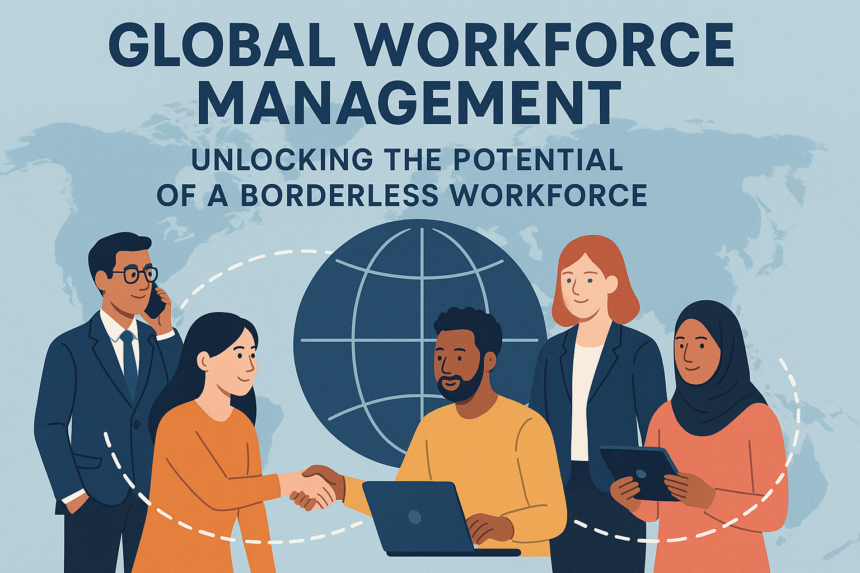In today’s interconnected world, businesses no longer limit talent searches to their backyards. From tech startups in Silicon Valley hiring developers in Bangalore to European firms onboarding customer support teams in Manila, global workforce management (GWM) has become the backbone of modern business strategy. But what does it take to manage employees across time zones, cultures, and legal systems effectively? Let’s explore.
What Is Global Workforce Management?
Global workforce management is the strategic coordination of hiring, onboarding, payroll, compliance, and performance monitoring for employees across multiple countries. It balances centralized organizational goals with localized practices, ensuring businesses can tap into global talent while navigating diverse labor laws, cultural norms, and operational complexities.
For example, a U.S.-based company using an Employer of Record (EOR) can hire a marketing specialist in Brazil without establishing a local entity—letting the EOR handle payroll, taxes, and compliance while the company focuses on strategy.
Why Global Workforce Management Matters
1. Access to Top Talent
- 72% of companies cite talent shortages as a critical challenge. GWM allows businesses to recruit from a global pool, filling skill gaps with specialized professionals.
- Tech giants like Google and Microsoft attribute 40% of their innovation to diverse, globally distributed teams.
2. Cost Efficiency
- Hiring in regions with lower labor costs can reduce expenses by 30–50% without sacrificing quality.
- EORs eliminate the need for costly legal entities abroad, saving up to $500,000 per country in incorporation fees.
3. Agility in a Changing Market
- Companies with global teams adapt 2.3x faster to market shifts, according to a 2024 McKinsey report.
- Remote work models enable 24/7 productivity cycles across time zones.
4. Compliance and Risk Mitigation
- Non-compliance with labor laws can result in fines exceeding $1 million. GWM ensures adherence to local regulations.
Key Challenges in Global Workforce Management
1. Navigating Cultural Differences
- Communication Styles: Direct feedback may motivate U.S. employees but demoralize teams in Japan, where indirect communication is preferred.
- Work-Life Balance: French labor laws mandate a 35-hour workweek, while U.S. norms often expect longer hours.
Solution: Implement cross-cultural training and use collaboration tools like Slack or Microsoft Teams to bridge gaps.
2. Compliance with Local Labor Laws
- India has 200+ labor laws that vary by state, including gratuity rules and minimum wage standards.
- Misclassifying contractors as employees can lead to penalties of up to $10,000 per worker in the EU.
Solution: Partner with an Employer of Record (EOR) to automate compliance and payroll.
3. Talent Retention Across Borders
- Employee turnover costs 1.5x annual salary for mid-level roles.
- Benefits expectations differ: Brazilian workers prioritize transportation allowances, while Germans value extended parental leave.
Solution: Tailor benefits packages using localized data and conduct stay interviews to address concerns.
4. Managing Remote and Hybrid Teams
- 63% of remote employees report feeling disconnected from company culture.
- Time zone differences delay decision-making by 2–3 days on average.
Solution: Adopt asynchronous communication and use tools like Trello for project tracking.
Best Practices for Effective Global Workforce Management
1. Leverage Technology
- HR Platforms: Tools like Deel or Remote streamline payroll, benefits, and compliance for 150+ countries.
- AI-Driven Analytics: Predict attrition risks by analyzing engagement surveys and performance metrics.
2. Implement Flexible Work Models
- Offer hybrid schedules to accommodate time zones (e.g., “core hours” for overlapping availability).
- Use results-oriented performance metrics instead of tracking hours.
3. Prioritize Cross-Cultural Training
- Train managers on cultural nuances (e.g., hierarchy in South Korean teams vs. flat structures in Sweden).
- Celebrate diverse holidays and traditions to foster inclusion.
4. Partner with an Employer of Record (EOR)
- EORs like Multiplier or Velocity Global handle:
- Payroll processing and tax filings.
- Local contract drafting and benefits administration.
- Compliance with labor laws and data privacy regulations (e.g., GDPR).
5. Build a Unified Culture
- Host virtual team-building activities (e.g., online escape rooms).
- Create global recognition programs that reward achievements across regions.
The Future of Global Workforce Management
1. AI and Predictive Analytics
- Algorithms will forecast talent gaps and recommend upskilling programs.
- Chatbots will resolve 80% of HR queries by 2030, reducing administrative workloads.
2. Blockchain for Secure Contracts
- Smart contracts will automate payments upon project milestones, reducing payroll errors.
3. Focus on Sustainability
- Companies will prioritize carbon-neutral remote work policies and eco-friendly office setups.
4. Rise of the Gig Economy
- 50% of the global workforce will freelance by 2035, requiring agile management of project-based talent.
Conclusion: Building a Borderless Workforce
Global workforce management isn’t just about hiring internationally—it’s about creating systems that empower diverse teams to thrive. By combining technology, cultural awareness, and strategic partnerships like Employer of Record (EOR) services, businesses can turn geographic dispersion into a competitive advantage. As the world grows smaller, the companies that master GWM will lead the next era of innovation.
Whether you’re a startup exploring new markets or an enterprise optimizing global operations, the principles of effective GWM remain the same: prioritize compliance, embrace flexibility, and invest in your people. The future of work has no borders, and neither should your strategy.







